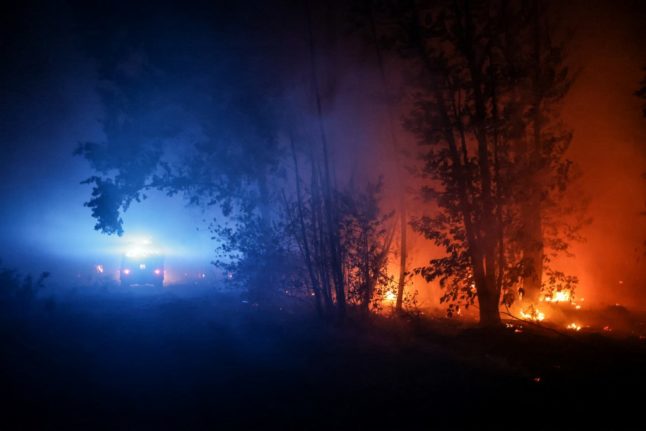Most of the country is sweltering under a summer heatwave compounded by a record drought – conditions most experts say will occur more often as a result of rapid climate change.
“We must continue, more than ever, our fight against climate disruption and … adapt to this climate disruption,” Prime Minister Elisabeth Borne said after arriving at a fire command post in the village of Hostens, south of Bordeaux.
The European Commission said four firefighting planes would be sent to France from Greece and Sweden, as well as teams from Austria, Germany, Poland and Romania.
“Our partners are coming to France’s aid against the fires. Thank you to them. European solidarity is at work!” President Emmanuel Macron tweeted.
L’Allemagne, la Grèce, la Pologne, et dans les prochaines heures la Roumanie et l’Autriche : nos partenaires viennent en aide à la France face aux incendies. Merci à eux. La solidarité européenne est à l’œuvre !
— Emmanuel Macron (@EmmanuelMacron) August 11, 2022
“Across the country over 10,000 firefighters and security forces are mobilised against the flames… These soldiers of fire are our heroes,” he said.
In total, 361 foreign firefighters were dispatched to assist their 1,100 French colleagues deployed in the worst-hit part of the French southwest.
VIDEO: Firefighters battle a fire in Hostens, in southwest France's Gironde, on the border with the Landes department. Close to 6,800 hectares of pine forest have gone up in smoke. pic.twitter.com/d7zP1zp5sa
— AFP News Agency (@AFP) August 11, 2022
A first contingent of 65 German firefighters, followed by their 24 vehicles, arrived Thursday afternoon and were to go into action at dawn Friday, officials said.
Among eight major fires currently raging, the biggest is the Landiras fire in the southwest Gironde department, whose forests and beaches draw huge tourist crowds each summer.
It had already burned 14,000 hectares (35,000 acres) in July – the driest month seen in France since 1961 – before being contained, but it continued to smoulder in the region’s tinder-dry pine forests and peat-rich soil.
Since flaring up again Tuesday, which officials suspect may have been caused by arson, it has burned 7,400 hectares, destroyed or damaged 17 homes, and forced 10,000 people to quit their homes, said Lieutenant Colonel Arnaud Mendousse of the Gironde fire and rescue service.
🔥 Terribles images d'Hostens en Gironde la nuit dernière. L'incendie a d'ores et déjà brûlé 4.000 hectares. 3.500 personnes ont été évacuées et 16 maisons ont été détruites. (via Pompiers de France) pic.twitter.com/4p1BUWWhTt
— Météo Express (@MeteoExpress) August 10, 2022
Borne said nine firefighting planes are already dumping water on the blaze, with two more to be in service by the weekend.
“Gigantic”
“We battled all night to stop the fire from spreading, notably to defend the village of Belin-Beliet,” Mendousse told journalists in Hostens.
On several houses nearby, people hung out white sheets saying: “Thank you for saving our homes” and other messages of support for the weary fire battalions.
“You’d think we’re in California, it’s gigantic… And they’re used to forest fires here but we’re being overwhelmed on all sides — nobody could have expected this,” Remy Lahlay, a firefighter deployed near Hostens in the Landes de Gascogne natural park, told AFP.
With temperatures in the region hitting nearly 40C on Thursday and forecast to stay high until at least Sunday, “there is a very serious risk of new outbreaks” for the Landiras fire, the prefecture of the Gironde department said.
Acrid smoke has spread across much of the southwestern Atlantic coast and its beaches that draw huge crowds of tourists each summer, with the regional ARS health agency “strongly” urging people to wear protective face masks.
The smoke also forced the closing of the A63 motorway, a major artery toward Spain, between Bordeaux and Bayonne.
The government has urged employers to allow leaves of absence for volunteer firefighters to help fight the fires.
Meanwhile, in Portugal, more than 1,500 firefighters were also battling a fire that has raged for days in the mountainous Serra da Estrela natural park in the centre of the country.
It has already burned 10,000 hectares, according to the European Forest Fire Information System (EFFIS).



 Please whitelist us to continue reading.
Please whitelist us to continue reading.
Member comments